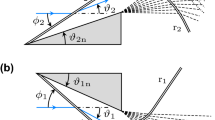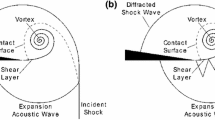Abstract
Experiments and numerical simulations were carried out in order to investigate the focusing of a shock wave in a test section after the incident shock has been diffracted by an obstacle. A conventional shock tube was used to generate the planar shock. Incident shock Mach numbers of 1.4 and 2.1 were tested. A high-speed camera was employed to obtain schlieren photos of the flow field in the experiments. In the numerical simulations, a weighted essentially non-oscillatory (WENO) scheme of third-order accuracy supplemented with structured dynamic mesh adaptation was adopted to simulate the shock wave interaction. Good agreement between experiments and numerical results is observed. The configurations exhibit shock reflection phenomena, shock–vortex interaction and—in particular—shock focusing. The pressure history in the cavity apex was recorded and compared with the numerical results. A quantitative analysis of the numerically observed shock reflection configurations is also performed by employing a pseudo-steady shock transition boundary calculation technique. Regular reflection, single Mach reflection and transitional Mach reflection phenomena are observed and are found to correlate well with analytic predictions from shock reflection theory.













Similar content being viewed by others
References
Sturtevant, B., Kulkarny, V.A.: The focusing of weak shock waves. J. Fluid Mech. 73, 651–671 (1976)
Izumi, K., Aso, S., Nishida, M.: Experimental and computational studies focusing process of shock waves reflected from parabolic reflectors. Shock Waves 3, 213–222 (1994)
Kowalczyk, P., Platkowski, T., Walus, W.: Focusing of a shock wave in rarefied gas. Shock Waves 10, 77–93 (2000)
Teng, H., Jiang, Z., Han, Z., Hosseini, S.H.R., Takayama, K.: Numerical investigation of toroidal shock wave focusing in a cylindrical chamber. Shock Waves 14, 299–305 (2005)
Skews, B.W., Menon, N., Bredin, M., Timofeev, E.V.: An experiment on imploding conical shock waves. Shock Waves 11, 323–326 (2002)
Paton, R.T., Skews, B.W., Rubidge, S., Snow, J.: Imploding conical shock waves. Shock Waves 23, 317–324 (2013)
Hosseini, S.H.R., Takayama, K.: Experimental study of toroidal shock wave focusing in a compact vertical annular diaphragm-less shock tube. Shock Waves 20, 1–7 (2010)
Eliasson, V., Apazidis, N., Tillmark, N., Lesser, M.B.: Focusing of strong shocks in an annular shock tube. Shock Waves 15, 205–217 (2006)
Eliasson, V., Apazidis, N., Tillmark, N.: Controlling the form of strong converging shocks by means of disturbances. Shock Waves 17, 29–42 (2006)
Eliasson, V., Tillmark, N., Szeri, J., Apazidis, N.: Light emission during shock wave focusing in air and argon. Phys. Fluids 19, 106106 (2007)
Skews, B.W., Kleine, H.: Flow features resulting from shock wave impact on a cylindrical cavity. J. Fluid Mech. 580, 481–493 (2007)
Skews, B.W., Kleine, H., Barber, T., Iannuccelli, M.: New flow features in a cavity during shock wave impact. In: 16th Australasian Fluid Mechanics Conference, Gold Coast, Australia (2007)
Bond, C., Hill, D.J., Meiron, D.I., Dimotakis, P.E.: Shock focusing in a planar convergent geometry: experiment and simulation. J. Fluid Mech. 641, 297–333 (2009)
Skews, B.W., Kleine, H., MacLucas, D., Takehara, K., Teranishi, H., Etoh, T.G.: Unsteady shock wave diagnostics with high-speed imaging. In: 28th Int. Congress on High-speed Imaging and Photonics, Canberra, Australia, November, 2008, vol. 7126, pp. 0F-1–0F-11 (2009)
MacLucas, D., Skews, B.W.: Cavity shape effects on shock-induced pressure distributions. In: Proceedings of the 27th International Symposium on Shock Waves, St Petersburg, Russia, pp. 282–287, 2009
Jung, Y.G., Chang, K.S.: Shock focusing flow field simulated by a high-resolution numerical algorithm. Shock Waves 22, 641–645 (2012)
MacLucas, D.A., Skews, B.W.: Kleine, H.: Time-resolved high-speed imaging of shock wave cavity interactions. In: 16th International Symposium on Flow Visualization, Okinawa, Japan, pp. 24–28 June (2014)
Levin, V.A., Nechaev, J.N., Tarasov, A.I.: A new approach to organizing operation cycles in pulse detonation engines. In: Roy, G., Frolov, S., Netzer, D., Borisov, A. (eds.) High-Speed Deflagration and Detonation: Fundamentals and Control. Moscow, pp. 223–238 (2001)
Gelfand, B.E., Khomik, S.V., Bartenev, A.M., Medvedev, S.P., Grönig, H., Olivier, H.: Detonation and deflagration initiation at the focusing of shock waves in combustible gaseous mixture. Shock Waves 10, 197–204 (2000)
Bartenev, A.M., Khomik, S.V., Gelfand, B.E., Grönig, H., Olivier, H.: Effect of reflection type on detonation initiation at shock-wave focusing. Shock Waves 10, 205–215 (2000)
Achasov, O.V., Penyazkov O.G.: Some gas dynamic methods for control of detonation initiation and propagation. In: Roy, G., Frolov, S., Netzer, D., Borisov, A. (eds.) High Speed High-Speed Deflagration and Detonation: Fundamentals and Control, pp. 31–44. ELEX-KM Publishers, Moscow (2001)
Jackson, S.I., Shepherd, J.E.: Detonation initiation via imploding shock waves. In: 40th AIAA/ASME/SAE/ASEE Joint Propulsion Conference and Exhibit, Fort Lauderdale, FL. AIAA 2004–3919 (2004)
Deiterding, R.: Block-structured adaptive mesh refinement–theory, implementation and application. ESAIM Proc. 34, 97–150 (2011)
Deiterding, R., Radovitzki, R., Mauch, S.P., Cirak, F., Hill, D.J., Pantano, J.C., Cummings, J.C., Meiron, D.I.: Virtual Test Facility: a virtual shock physics facility for simulating the dynamic response of materials. http://www.cacr.caltech.edu/asc (2007)
Pantano, C., Deiterding, R., Hill, D.J., Pullin, D.I.: A low-numerical dissipation patch-based adaptive mesh refinement method for large-eddy simulation of compressible flows. J. Comput. Phys. 221(1), 63–87 (2007)
Ziegler, J.L., Deiterding, R., Shepherd, J.E., Pullin, D.I.: An adaptive high-order hybrid scheme for compressive, viscous flows with detailed chemistry. J. Comput. Phys. 230, 7598–7630 (2011)
Liepmann, H.W., Roshko, A.: Elements of Gasdynamics, p.778. Dover Pulications, Mineola (2013)
Deiterding, R.: A parallel adaptive method for simulating shock-induced combustion with detailed chemical kinetics in complex domains. Comput. Struct. 87, 769–783 (2009)
Berger, M., Colella, P.: Local adaptive mesh refinement for shock hydrodynamics. J. Comput. Phys. 82, 64–84 (1988)
Ben-Dor, G.: Shock Wave Reflection Phenomena. Springer, New York (2007)
Deiterding, R.: High-resolution numerical simulation and analysis of Mach reflection structures in detonation waves in low-pressure H\(_2\)–O\(_2\)–Ar mixtures: a summary of results obtained with the adaptive mesh refinement framework AMROC. J. Combust. 2011, 738969 (2011)
Author information
Authors and Affiliations
Corresponding author
Additional information
Communicated by K. Kontis and A. Higgins.
This work has been supported by the Young Scientists Fund of the National Natural Science Foundation of China through Grant No. 51106178.
Rights and permissions
About this article
Cite this article
Zhang, Q., Chen, X., He, LM. et al. Investigation of shock focusing in a cavity with incident shock diffracted by an obstacle. Shock Waves 27, 169–177 (2017). https://doi.org/10.1007/s00193-016-0653-0
Received:
Revised:
Accepted:
Published:
Issue Date:
DOI: https://doi.org/10.1007/s00193-016-0653-0




